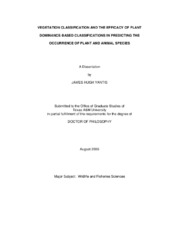| dc.description.abstract | One strategy for conserving biodiversity is to select large-area preserves that complement each other so the maximum number of species is conserved. Estimates of biodiversity and complementarity are needed for optimum selection of preserves. Comparisons are made in part by defining and mapping vegetation associations under the assumption that candidate areas with no associations in common likely have high complementarity. Conversely, areas with many associations in common have low complementarity. Vegetation associations are often distinguished on the basis of the dominant plant species. Associations with markedly different dominants (e.g., evergreen and deciduous trees) are expected to indicate high complementarity. In this study I evaluated the complementarity of an evergreen forest and a deciduous forest. I also evaluated a dichotomy of subsoil texture. I compared 6 groups of species: (1) woody plants (Dicotyledonae), (2) birds (Aves), (3) small mammals (Mammalia) plus herptiles (Amphibia) and (Reptilia), (4) beetles(Coleoptera), (5) ants (Formicidae) plus velvet ants (Mutillidae), and (6) spiders (Araneae). I made the comparisons using canonical correspondence analysis (CCA), redundancy analysis (RDA), logistic regression, and 3 indices of biodiversity. In this study the species of dominant tree was more strongly associated with the distribution of species than was soil texture. Dominant tree and soil texture used together greatly improved the association with the distribution of species. The association defined by the dominant evergreen tree was not different than the association defined by the dominant deciduous tree, based on the criteria that an association is defined as having a Jaccard similarity index between 0.25 and 0.5. Similarities >0.5, as in this case, are too similar to be an association and are termed a subassociation. Evergreen forests and deciduous forests do not necessarily have high complementarity. Different dominant plant species do not necessarily define different associations. Dominant plant species are not necessarily useful in defining associations or higher-level classifications. | en |


